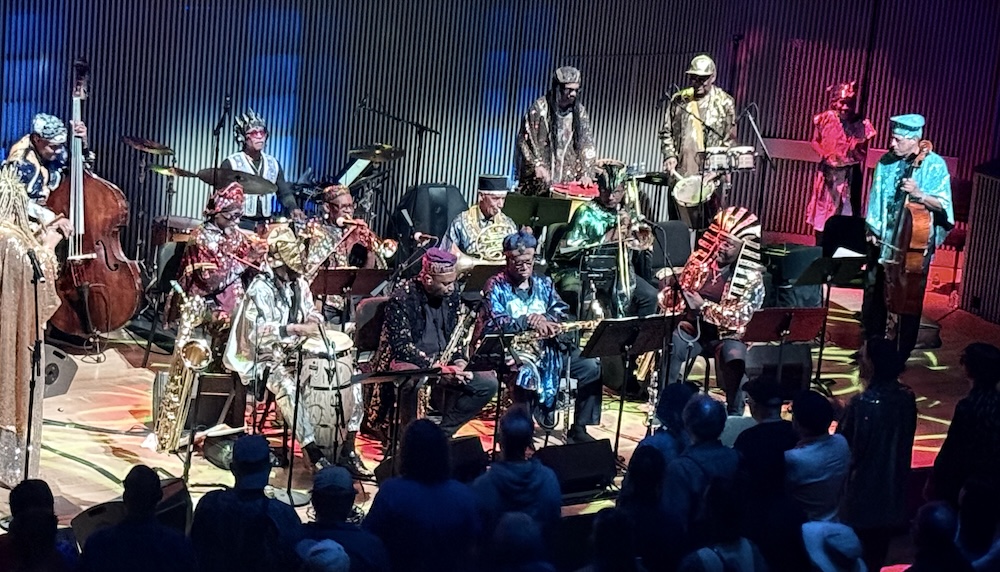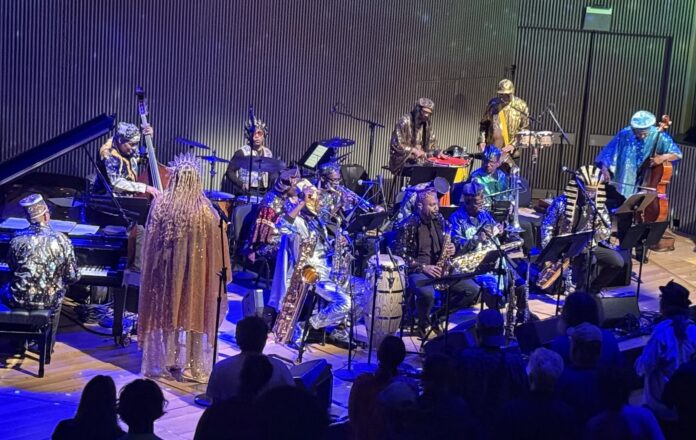Knoel Scott instructing Sun Ra’s Arkestra on the banstand resembles what it would look like if NFL coach Mike Tomlin were to conduct Stravinsky’s Rites of Spring. Composer Scott stepped into the role previously held by the ever-so-saintly centenarian Marshall Allen, who is currently restricting his travel (but still very active in Philadelphia, having just released his debut solo record this past February).
On this first of a four-night engagement on July 31 by the pioneering Afrofuturist band at SFJAZZ, Scott’s was working non-stop during the two-hour performance. Standing, sitting, leaning over, bobbing, and weaving—from my seat at the nearly-sold-out, 700-seat Miner Auditorium, I can see that he was constantly switching from baritone sax to alto, in one moment cueing the trombone player for his solo, the next hopping on the djembe drum. He’d then proceed to unleash borderline aggressive hand and finger combinations to indicate what accents he wanted from the horn line.

He self-managed his own solos, and of course, maintained his number one job as storyteller and ambassador to the audience, explaining the intricacies of the vibrant and wild repertoire written by the one and only Sun Ra. These tactics? Essential to delivering the sounds of Herman Poole Blount, aka Sun Ra, who was born in Alabama 1914 and would go on to become the Chicago-based jazz keyboardist, composer, philosopher, and all-around cultural force.
In a class I took from him at the University of Hartford, the late alto-saxophonist Jackie McLean explained that when Sun Ra wanted you in his band, he’d just show up at your gig and stare at you for your entire set. That same glare, decades after he died in 1993, would later transform him into a meme—or rather, a thought virus hovering above both popular and experimental music, 32 years after his passing.
Sun Ra wrote intricate arrangements and maintained that Afrofuturist modern vision which can be heard in Parliament Funkadelic, Earth, Wind, and Fire, Deltron 3030, OutKast, Janelle Monae, and Solange. His sound, innovation, and logic, the way he created music for the 21st century even while delivering the alien narrative of the struggle to exist on planet Earth, left behind an ever-flowing geyser of artistic creativity. Daft Punk, Lady Gaga, David Bowie during his Ziggy Stardust phase, and Björk have all taken Ra’s influence up in their own iconoclastic adaptations.
Listen, there is no precursor to Sun-Ra. Just before and after.
So many heavyweights shoplifted, got inspired, and then proceeded to reap financial and critical success from Ra’s eccentric beliefs. Much—no, far more than the actual creator enjoyed during his lifetime.
This night, with the dance floor ticketholders creakily moving, only slightly dancing, was the first of a four-night stand. While the theme was cosmic space jazz, “Big John’s Special”, a rhythmic vessel that carries all the virtues of jump-blues at it’s finest, led to the flickering of horn solos just as shimmery as those interstellar costumes.
It sounded like a big band alarm, and had one youthful patron on the balcony doing enthusiastic jumping jacks. Not the dance moves my grandmother once explained to me while detailing her experiences at big band jazz dances in Harlem in the ’40s—but each generation has its way, I guess.
Sun Ra wrote, performed, and lived in multitudes, and his compositions mirrored those conditions. Hence, Scott’s constant direction also worked as an entry point for confused first-time Arkestra attendees, myself included, to follow along. ‘Cause, similar to life, it was a lot.
Ra foresaw the idea of an avant-garde jazz big band/space-age traveling core of musicians who present decades upon decades of jazz music with them wherever they land in the world.
When you join Sun Ra’s band, you don’t quit. You are in it for life. So these musicians are speaking with their instruments at the times they observed, firsthand.
Currently, they stand, march, sway, and shift nimbly as a 19-member orchestra, with a dancer and vocalist too, built intentionally to change the planet through music. A 20th-century notion, desperately needed today.
His arrangements, written 50 to 72 years ago, contain more wit, complexity, and lighthearted zest than notable rock bands The Killers, Interpol, or The Shins drunk on a Morrissey YouTube binge. Ra’s arrangements, on this evening, featured horn lines that arrived just slightly off-beat, which initially sounded like a big-loud mistake. But after repetition, those same lines—as if Sun Ra from the grave or the cosmos kept pestering “do you get it?”— those same runs of notes started to land swimmingly, resembling a pork-pie hat worn cocked to one side.
Listen, ChatGPT, AI, or whatever you’ve got for a Google machine in your pocket, has nothing on Sun Ra; his well of creativity remains abundant with intuitive ideas and emotions that champion anything cooked up in this computer-technology-driven world. That humanity, with its sharp repartee, triumphs over all button-mashing trickery. Sun Ra Arkestra, active since 1952, is one of the oldest and most influential Black big band jazz groups in the world. Period.
Respect your elders. Formed in the 1950s—if it were a physical building, structure, or site, it’d be a national landmark several times over.
That mystical big band, adorned in spangled capes, violet cloaks, mesh caps, pyramid hats, and Pharaoh’s headdresses, this mobile cannon, descended upon Cloud City, marched through the front row on their newly emblematic rendition of “Lights On A Satellite” that played as a moving hymnal, full of horn solos, some out, others sweet, all riding on this spirit swirling in the ether, easily brought tears to patrons’ eyes.

All of this took place while the rest of San Francisco was visibly tripping, drooling over itself (dancing bears projected upon the Embarcadero clock tower Thursday evening included), welcoming the anniversary of a Haight Street band in their modern 21st-century realignment. The City and Mayor Lurie were readying for a hopeful profit off their three-night engagement in the overused outdoor element that would be Golden Gate Park. Counting tickets, hotel fees, restaurant fees, and nightlife endeavors, all told the proceedings could have clicked over $100 million, manna for the city’s ailing tourism industry.
But what about the city’s failing cultural awareness and sense of history? SF’s ability to process and celebrate multiple decades of varying styles of American classical music? Tenets that this city used to stand by and be proud of? No bigs. The Sun Ra Arkestra still humbly marched on into the uncertain future, bringing its legacy along wherever it may arrive.
Marching offstage at concert’s end, Knoel Scott reminded us all: “We travel the spaceways.”






